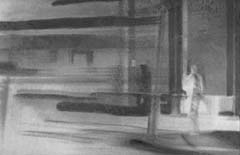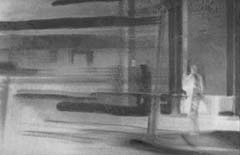Part of Fall 1997
“Wrapped in the skin of this form that is known as the body lies the memories and the soul of that self. So too, the skin of the film is the emulsion which holds together all the photochemical secrets just under its surface. This work is a testament to my unwrapping of these two energies and blending those photochemical secrets with my energy of unconscious … sometimes conscious memories of the events that took place upon the expulsion of one life to another. A metamorphosis that could really only be understood when standing in a foreign place. A region of myself and of film that as of yet to that point had not been charted. I created the destination and the two skins began to crack and peel like the first good sunburn of the summer. Underneath raged all the chromatic scale of emotion, that was to give birth to the notion, a new beginning. At last I could not deny it, the merging of myself with the film gave rise to internal events realized through much thought before/during/after the fact surfacing in ways that only my most sacred thoughts could. It is the story of a personal tragedy overcome by sharing misery with company to shed the bad blood to allow the red thread that binds us all to run the oxidized route of freedom without fear and let old skin which has been discarded be wrapped in the wind of the Mistral swept up for all the senses, fresh again. Beautiful but terrible to fight and feel another day.”
(Carl Brown)
“Over the past fourteen years, I have come to realize that, to a large extent, my workings in film have come out of a larger past, the discipline of alchemy. In alchemy, art is the imitation of nature in its mode of operation.”
“The highest meaning of alchemy is the knowledge that all is contained in all. This realization of truth on the plane of the soul means the ability to take it (realization) to the body through the senses and then release this knowledge onto the surface of the film. In some way, the purity of image, as well as my intent at that moment, must be at one, in order that the base metal silver halide becomes receptive to the iron oxide conversion in which a rainbowed delight of precious colour becomes my alchemical palette.”
“In my new film, Air Cries, “Empty Water” I have dealt with the interaction between the environment and the camera/eye. I have converted the base metal silver, which is the construction of film and deconstruct to the rainbow of light which is the resultant conversion to the precious metal. I would like to once again refer to alchemy as a unifying factor between the realization of the idea and completion of the emotion/thought.”
(Carl Brown)
“On the path that Man Ray pioneered in the Twenties, Brown makes films from what heats and colds, the chemicals and the light-gouges together create in the cinema’s surface. Brown treats them like the play of sensations on the skin of his art.”
(Bart Testa)
Excerpt from
‘Expériences chromatiques dans le cinéma contemporain”
by Nicole Brenez
“Two contemporary and contrasting experiments, the work of Carl Brown and the one of Cecile Fontaine, use colours capable of redefing the nature of the film itself, of transforming an optical support into a physical subjectivity. In the same style as other attempts, the splashing of colour by Frampton served to promote the image, which found itself strangely buried beneath the construction of the film. Under Carl Brown and Cecile Fontaine, the filmwork consists in finding an unedited equilibrium between the analogical image and a film substance sculpted by the colour. Is the image the principal element of the movie? Where is it exactly? Between the material and the immaterial, the continuity and the discontinuity, what about its substance? But once this common problematic project if launched everything differs from one experiment to the other. The art of Carl Brown adheres essentially to the values and to the techniques of the development. To plasticize the film Carl Brown reinvented the procedures and the tools of the pulling (drawing), the gauging and the drying. This chromatic material is the toner that he spreads over the film so as to leave a trace of the arm movements, then works with help of two principal procedures: the Sabattier effect, being the double development with inversion of optic values, and the plaiting, being a doubling of the gelatine, caused by the difference in temperature between fixing solutions. With those techniques of pure chromatic mounting (setting) which through folds, fractures and the explosion registers the conversion work which is the development at the heart of the colour itself, Carl Brown exalts what he calls the ‘the depravity of toner’ Condensations of Sensation (1987/ 73 min.) that lays down the original signature of the development process; over a series of reticulated film set-ups, (found footage of commercials dating from the 1950’s, cityscapes, foregrounds describing a crossroad, deliberately amateurish images of the realization of a movie, touristic sights), the colour falls like a never-ending faultless rain. First it falls softly in a smattering of colors, then becomes denser, more intensified, more opaque. The phonician reds, mixed with indigos and carmines, do not anymore devour the figurative outlines but become dilated until deflagration. In the project the proper strength of a homogenic fabric and of a savage buckling oppose each other, superpose themselves on a curtain of winding hues and the chromatic figures of the discontinuation and the shapeless: effervescence, colours, foams, flakes and stains, to create prominent motions in relief that do not stop repelling the analogical images to an abstract depth in front of which the colour twists like coalescent lava. Condensations of Sensation as other films of Carl Brown (as Re:Entry, 1990/ 87 min.) or certain creations that share the same plastic design as Echo Anthem of Mark Street (1990/8 min.) respects a form of classic narrative, the one of the voyage: its exploratory progression leads from one identifiable type of image (the negative for example) to and absolutely frenetic nameless chromatic; the colours stacked one upon the other, declining by themselves, have no longer names, colours, connections, nor even describable motion. The variegation that Carl Brown brings to his palate lies somewhere between the ‘psychedelic and the oils of Van Gogh’ as Carl Brown says. Their deeply skilled character determines certain visual properties: hues that are impure, blended, broken, keep in themselves the returning occurrence, lead back by their genesis under a form of an immediate black and white vibrato, starts of diffused light in the pungent dust of the toner, at once already converted and still shapeless, still obscure, always susceptible to mould into a different shade and to force a new texture to appear. However the chromatic frenzy does not constitute an end in itself, as one can notice by means of a short return to two analogous prints in sepia, two prints, one deframed to the left and one other full screen of a small shape crossing the street, of having for one moment suspended the chromatic maelstrom that occupied the edge, these two simple prints become a major film occurrence. During the crossing, Brown’s specification of the voyage, everything has been crossed and preserved; it is not a question of swallowing the mimitry but, as the intermittent return of the white screen attests, to confirm and updated the extensive nature of the film. Carl Brown, bringing up in his own way the Eisenstein project, describes this enterprise as opening up the screen. However, it is less a question of animating a surface by imaginatively opening it from the outside then covering and recovering it so that each colour coat, itself mixed and complex, falls on the previous one without being annulled or replaced: it superpose itself on it while renewing the appearance of the cinematographic matter, sometimes fluid up to the limits of the transparency, sometimes so dense and opaque that the colour seems to suffocate its own light in a convulsive way. Blending, mixing confusion, combination fusions, ‘benzedrine montage’, sums up precisely Mike Hoolboom: by inventing the unedited links to fertilize the possible relationships between coats and undercoats, between analogue planning and all-over abstract, between unstringing accumulations. Through wafering and leafing, Carl Brown commutes the film’s density into depth.”
Translation by Julian de Meester
Carl Brown Filmography:
Mine’s Bedlam, Super 8, 8 min. 1980
Urban Fire, 16mm, 15 min. 1982
Full Moon Darkness, 16mm, 90 min. 1985
Condensation Of Sensation, 16 mm, 73 min., 1987
Drop, 16mm, 4.5 min., 1989
Re:Entry, 16mm, 87 min., 1990
Sheep, 16mm, 7 min., 1991
BROWNSNOW, 16mm, 134 min., 1994
Air Cries, “Empty Water”
Part 1: Misery Loves Company, 16mm, 60 min., 1993
Part 2: The Red Thread, 16mm, 60 min., 1995
Part 3: Le Mistral, beautiful but terrible, 16mm, 117 min., 1997

